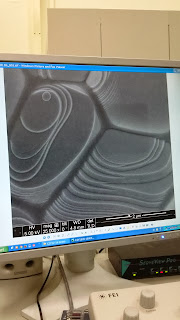Classified.
Day 5
Differential Scanning Calorimetry (DSC) - your one-stop solution to solve all thermal needs (citation needed). Want to obtain glass transition temperature range? How about crystallization, melting, cross-linking, and oxidation temperatures? Then DSC is the technique for you!
That is, after weighing <5mg of sample in a microbalance and carefully loading it onto a hydraulic press to encapsulate it in an aluminium hermetic pan which is then placed into the carefully programmed DSC machine pre-cooled to 193K. Now, you might question: what if you're careless (lazy) during preparation? Well, you get equally deserving results:
When you are supposed to get this:
As seen from the (professionally done) PolyUtherene graph, glass transition temperature is at 217K followed by the 256K peak (crystallization tempertature) and the 300K melting range. For our sample, we should have increased the sampling frequency to get a more defined graph. Time wasted, lesson learnt, time well-spent.
After Lunch, it was yet again the return of the Jason-saga. We went from door-to-door (passed-by many doors, more like) to find the best coffee in NTU and finally found it! Wanna make a guess where is it? Well, I'll let you keep on guessing while I enjoy my coffee till Day 5 is over.
(*Hint: It is somewhere at 23.4 degrees northeast down under up above the sky so high in the Bermuda Triangle.)
Day 6
Classified.
No really, classified.
Well, some lab visits here and there....
Fine - We got the opportunity to enter several advanced defence laboratories (for Singaporeans only. Jealous?). There, we got treated to an awesome showcase of several projects: Ever thought that plasma-imbued nano-composite armour technology was so Tony Stark? Well, so did we. Keyword: did. The rest are..... Classified... so just let these pictures speak for themselves:
Then again, some parts are just so Classified that picture-taking was forbidden (even before entering). Lets just say that at some secret location X, there's this special machine Y that does magic for next-gen prototype ceramics. At secret location Z, things are encased in steel tanks and flying about in mach 3 that will even make sheets of tungsten carbide cry (So much for toughness). This giant will make Spilt-Hopkinson pressure bars look like infants.
But here's something we can share: Focused Ion Beam Microscopy and Micro-machining (probably where nano-tubes are manufactured). Scaled-down material testing on the nano-scale removes the need of the aforementioned beast apparatus for testing during R&D phase.
Like as before, let these pictures do the talking:
We will be continuing our tour tomorrow. Stay tuned....
But then again, it's classified.
After Lunch, it was yet again the return of the Jason-saga. We went from door-to-door (passed-by many doors, more like) to find the best coffee in NTU and finally found it! Wanna make a guess where is it? Well, I'll let you keep on guessing while I enjoy my coffee till Day 5 is over.
(*Hint: It is somewhere at 23.4 degrees northeast down under up above the sky so high in the Bermuda Triangle.)
Day 6
Classified.
No really, classified.
Well, some lab visits here and there....
Fine - We got the opportunity to enter several advanced defence laboratories (for Singaporeans only. Jealous?). There, we got treated to an awesome showcase of several projects: Ever thought that plasma-imbued nano-composite armour technology was so Tony Stark? Well, so did we. Keyword: did. The rest are..... Classified... so just let these pictures speak for themselves:
Tainted glass? Nope. Neodymium-doped Yttrium Aluminium Garnet.
Same material 10 years down the road....
All we can say: What a waste of Diamonds....
Latest innovation for SK-II facial treatment
Then again, some parts are just so Classified that picture-taking was forbidden (even before entering). Lets just say that at some secret location X, there's this special machine Y that does magic for next-gen prototype ceramics. At secret location Z, things are encased in steel tanks and flying about in mach 3 that will even make sheets of tungsten carbide cry (So much for toughness). This giant will make Spilt-Hopkinson pressure bars look like infants.
But here's something we can share: Focused Ion Beam Microscopy and Micro-machining (probably where nano-tubes are manufactured). Scaled-down material testing on the nano-scale removes the need of the aforementioned beast apparatus for testing during R&D phase.
Like as before, let these pictures do the talking:
Nano-sized ceramic grains with contours
Focused Ion Beam Microscopy. Tony Stark be proud.
What your hair's hair will look like
But then again, it's classified.
















